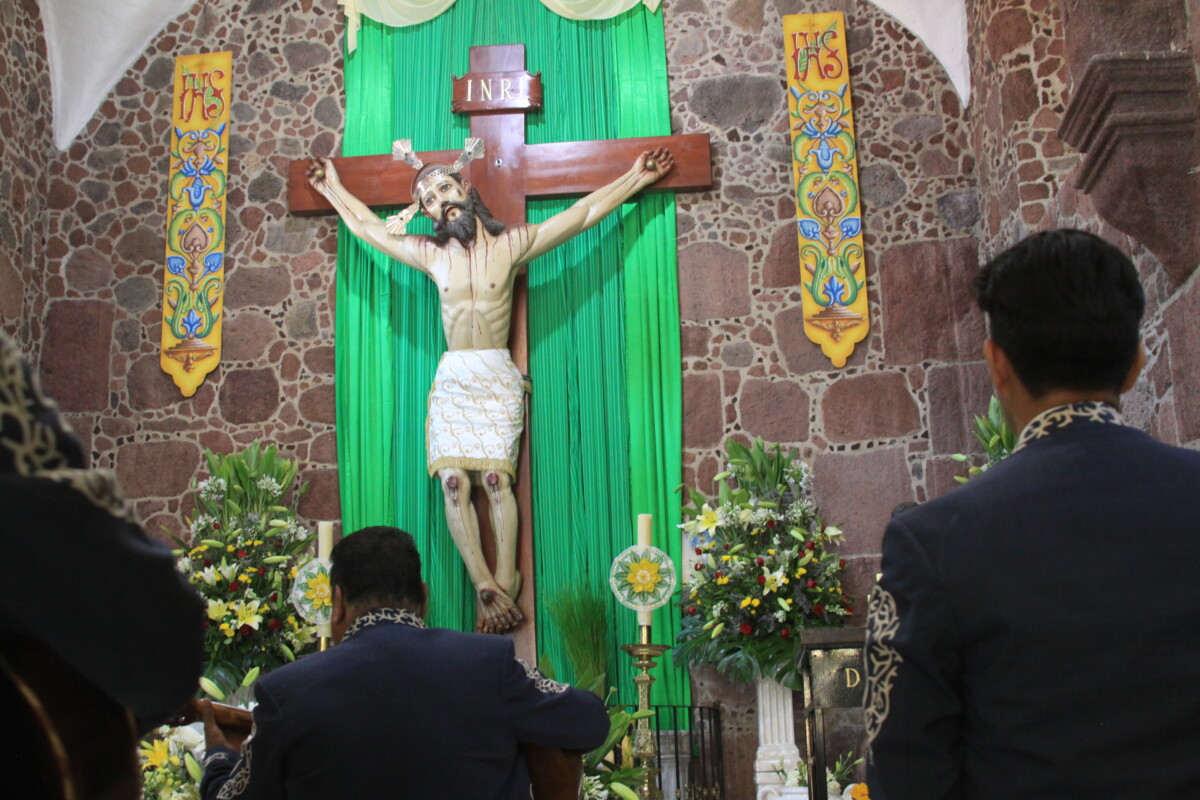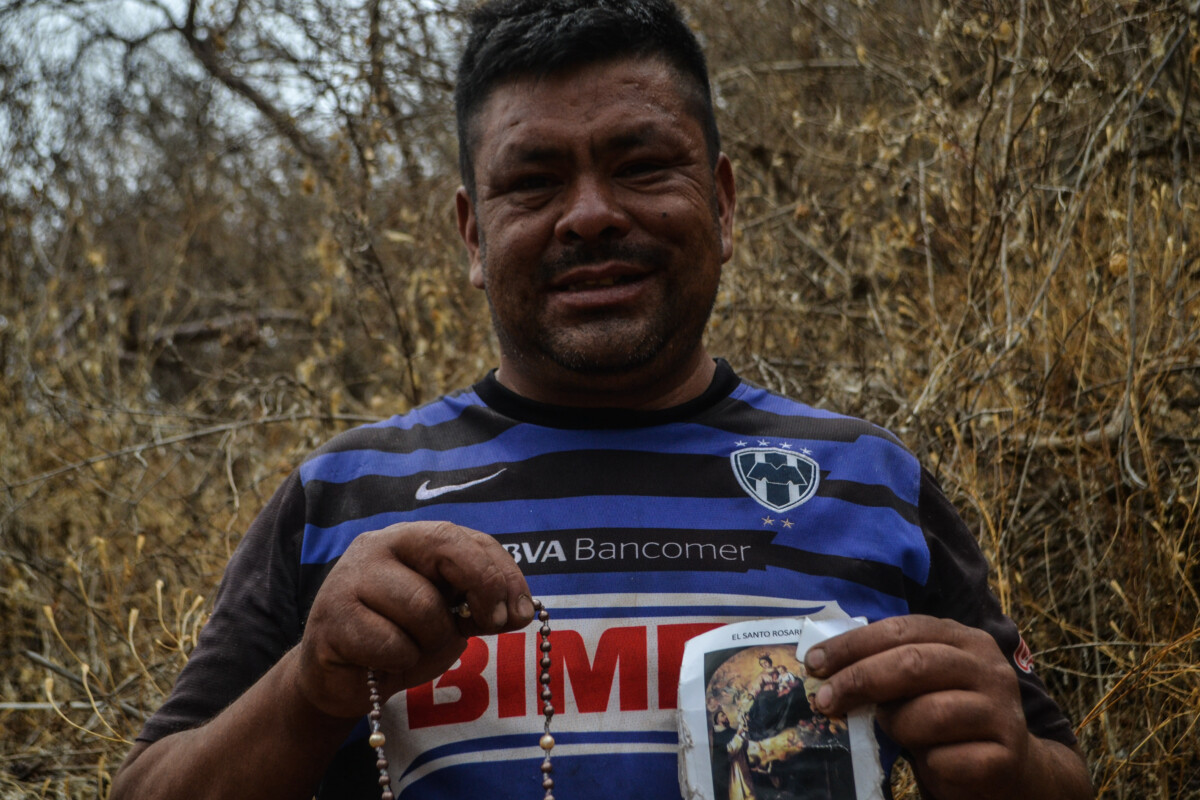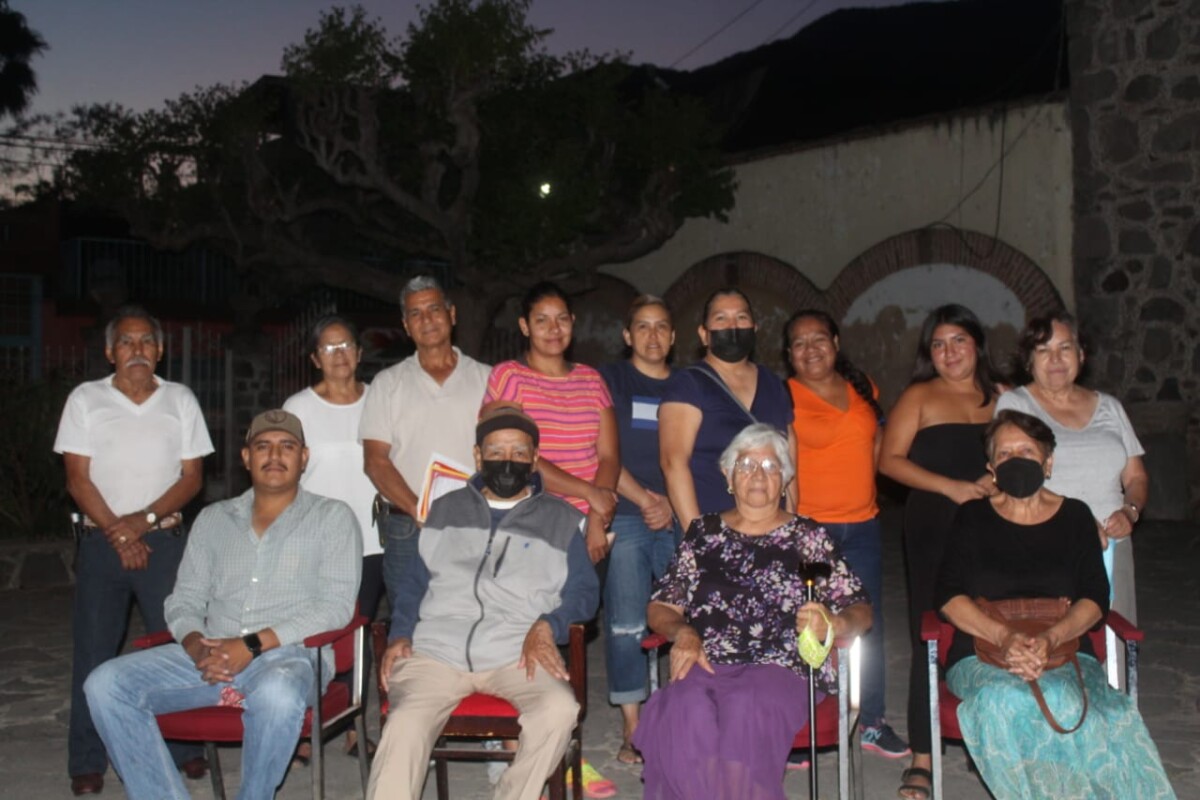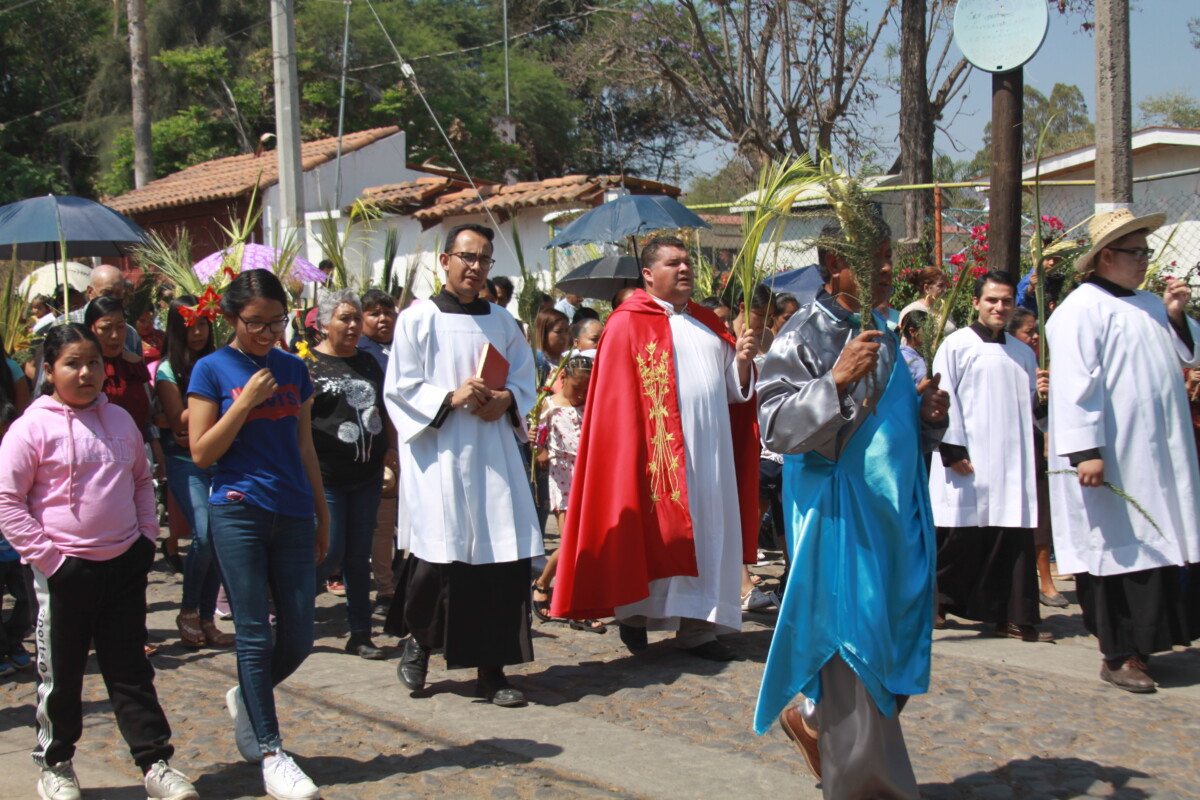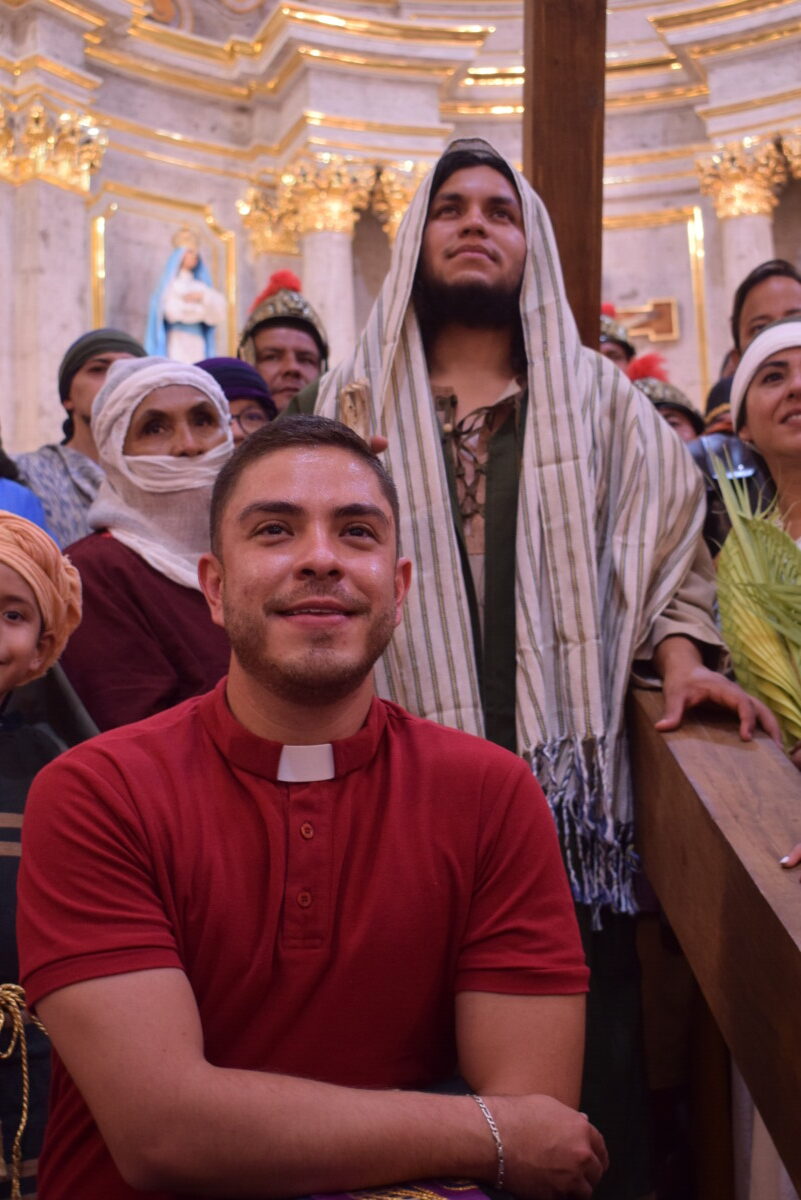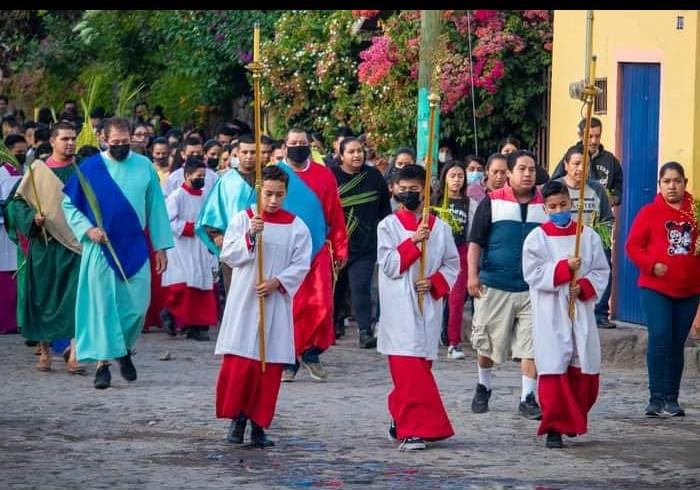religión
Lakeside Chronicles
The traditional Las Mañanitas are sung by the mariachi in the festival of the Lord of Huaje.
By: María del Refugio Reynozo Medina
NOTE. Just as Mexican Catholics recognize many representations of “la Virgen,” they also recognize many representations of Jesus Christ. Usually these are depicted with a sculpted figure, sometimes of great antiquity and value, often dating back to the 1500s or 1600s when Spain was establishing the church here. These representations have their own names and their own celebration days, and are often credited with performing miracles on behalf of the faithful. This article refers to the celebration for “el Señor del Huaje,” a large figure of the crucified Christ made of the wood of the “huaje” or tamarind tree, which is celebrated with a festival and procession on the first Sunday in May each year.
The streets of Jocotepec are still in darkness. It is about 5:30 in the morning and the orange flowers and green foliage of the flame-red tabachine trees at the entrance of the temple look grayish.
About a hundred people are already gathered inside and outside the temple, under the leafy trees. Dances are being prepared and the brass band is playing. Steaming pots rest in their stands. Chocolate, cinnamon and tamarind atole (a hot cornflour drink) awaits the faithful who gather at the temple of the Señor del Huaje, for his feast.
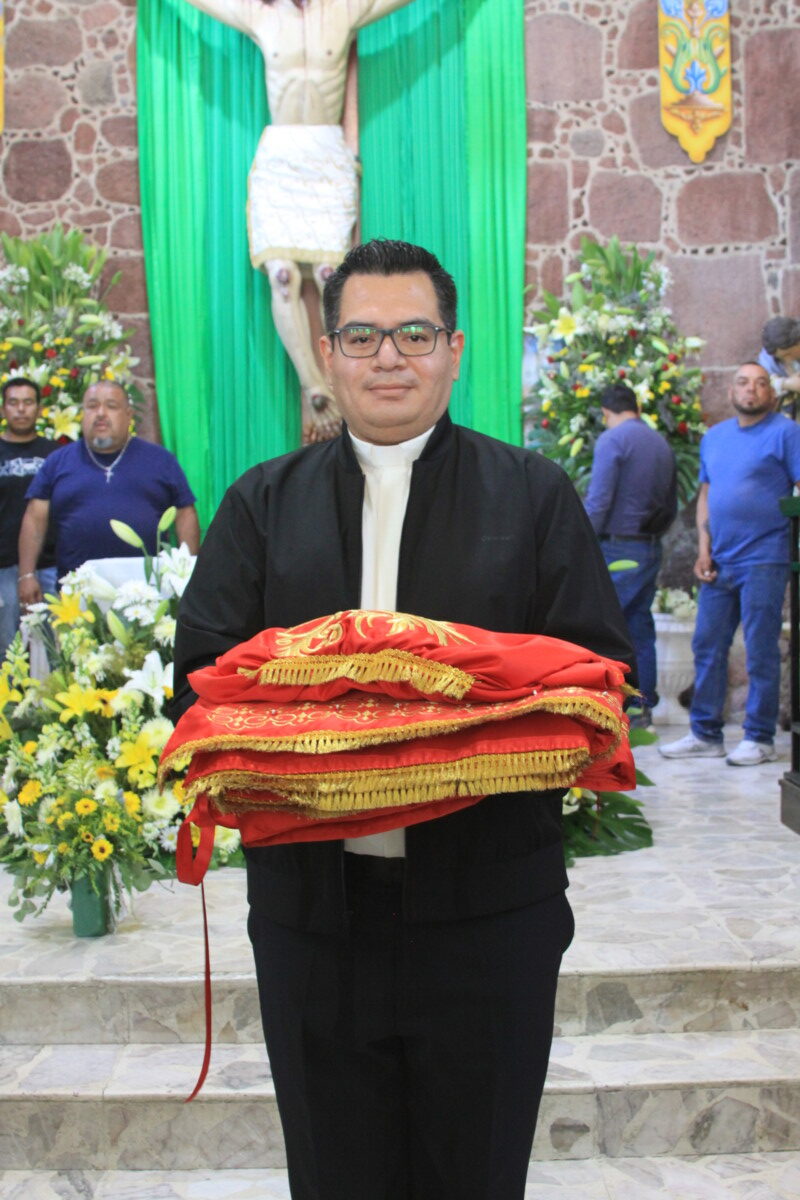
Father Eduardo Garcia Orta with the new cendal or loincloth that was presented for the festival of the Lord of the Huaje. In the words of Father Lalo, the fiery red symbolizes the spilled blood embroidered with golden threads as a symbol of royalty.
The band is playing a popular dancing song, El Mono de Alambre (The Wire Monkey). The men of the band sing. The bells ring the second call for the six o’clock mass and Father Mario Fernando Sandoval Varela comes out of the temple to welcome the cargueros (the men who will be carrying the figure of the Señor del Huaje in the procession).
“How about the music,» he says. And El Mono de Alambre is interrupted by the chants of a procession.
“Long live my Christ, long live my King,” some women sing, and the band stops.
Soon the San Cristobal Band arrives and intones the traditional Las Mañanitas, followed by waltzes and pasodobles dances, which permeate the Eucharistic celebration.
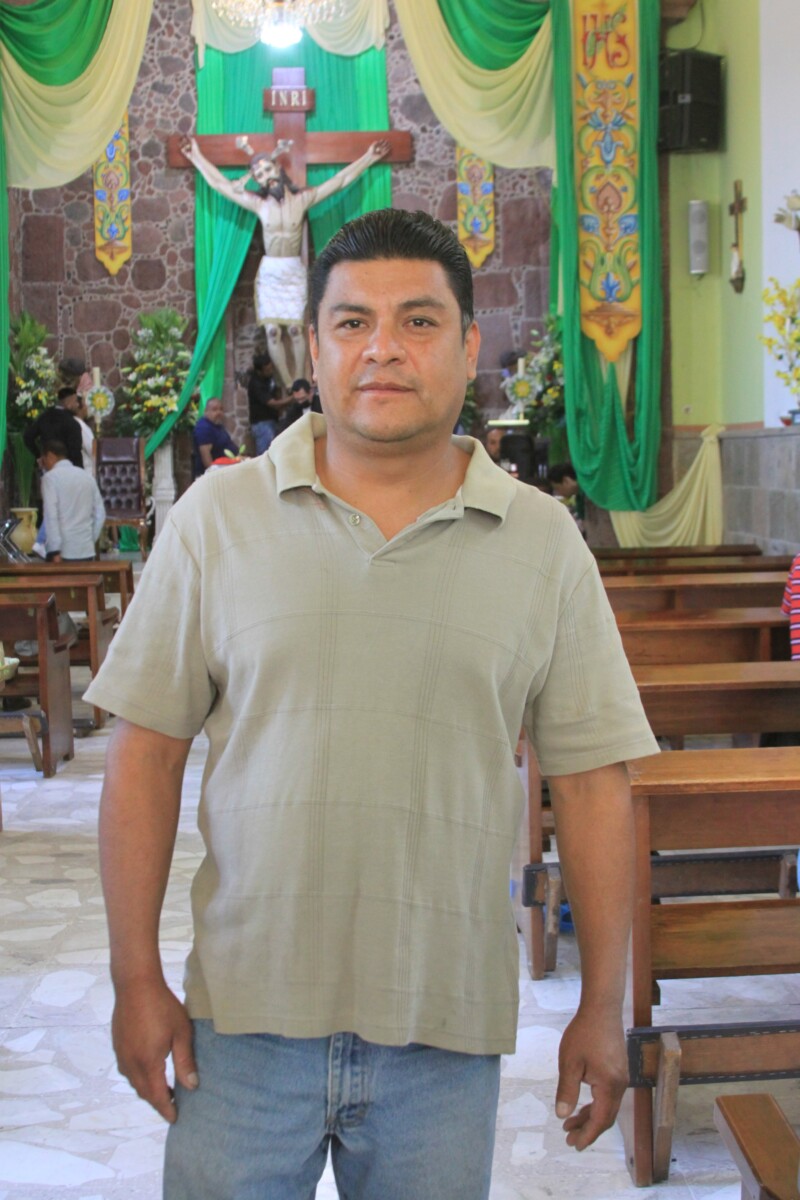
Carlos Mendo has been responsible for the honor guard of the Lord of Huaje for ten years.
At the end of the mass, a man reads a list of the various expenses of the festival: the music, the dawn ceremony, decorated candles, dances, dinner for the musicians and the castillo or fireworks tower. He names the families who will assume the expenses. Many of them are from the Nextipac neighborhood
At the exit of mass, they begin to distribute the drinks and the dancers execute their movements to the sound of the drum and the caracol, a prehispanic musical instrument like a trumpet made of shell or ceramic.
Today is expected the visit of Father Eduardo Garcia Orta who spent three years in the community of Jocotepec and still retains the affection for these lands and the veneration for the Lord of the Huaje.
Father «Lalo» as the community calls him, is on his way with a very valuable cendal, a beautifully decorated loincloth that will be wrapped around the image of Christ to be premiered by the Señor del Huaje in his feast. Some representatives of the honor guard gather and wait eagerly for its arrival. «They say that this loincloth has golden threads» a discreet and festive voice is heard. There is much excitement to see it and to welcome the priest.
Upon his arrival, Father Lalo is received with signs of affection. They congregate at the altar and everyone approaches to see the loincloth, which is bright red with gold embroidery.
To carry out the change of the loincloth, putting the new one in place of the current one, the men remain in the enclosure and the women wait outside. A woman who accompanies me in the wait says, “These are men’s duties; women have no business being there.”

The members of the guard of honor wear bright red shirts to guard the Lord of the Huaje.
Carlos Mendo is the main person in charge. For ten years, he has overseen the honor guard. It is made up of about a hundred people, mostly men and a few recently integrated women. He was questioned by some parishioners for having allowed access to women.
“God doesn’t say you don’t or you do,» he responded confidently.
Mr. Roberto Mendo, Carlos’s father, was the last person in charge and left the position to his son.
It is a great responsibility, says Carlos, because it means taking care not only of the image of a beloved Christ, but also of a piece of historical artistic value. The last restoration cost 140,000 pesos (about US$7,000), which were raised with donations from the community.
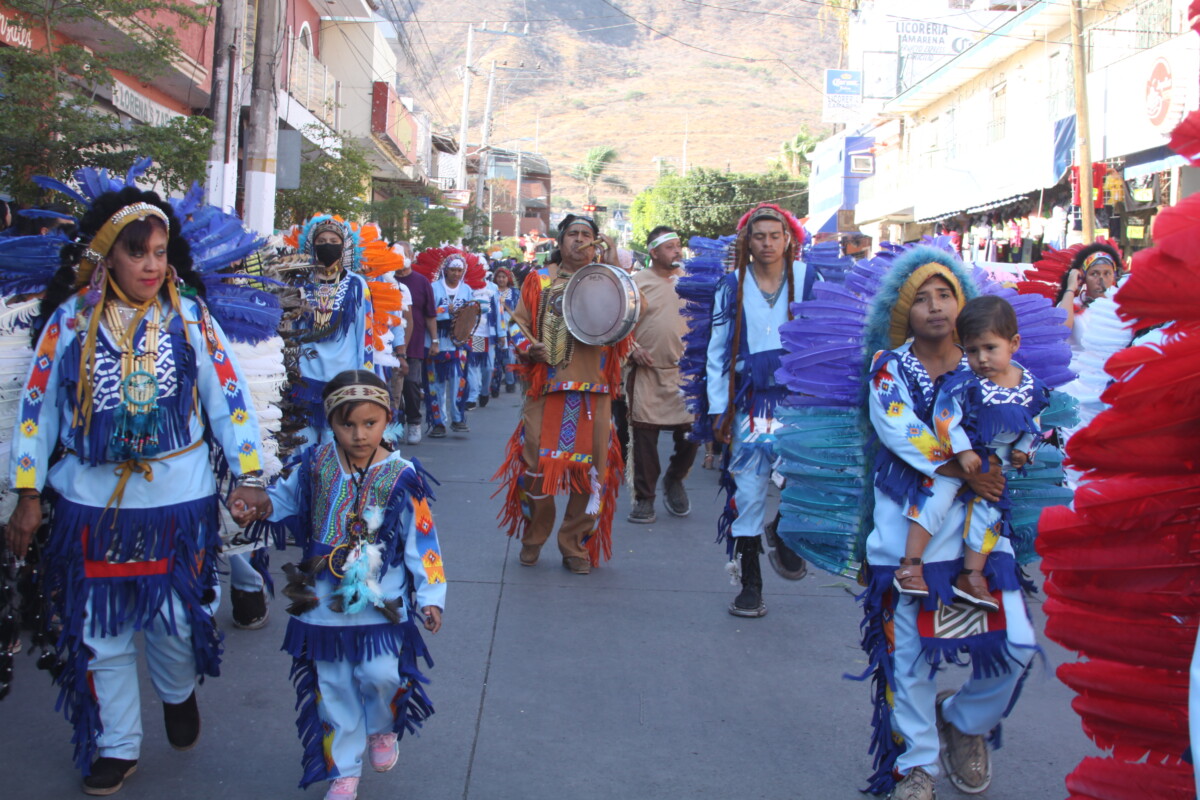
The dances are present in the procession in which children and adults participate.
It is a difficult responsibility, but it is also a blessing. «Now I only ask for work and health,” he said.
Víctor, a member of the honor guard, shares a testimony. His wife was sick for a couple of months, having inexplicably lost the mobility of her body, during which time she remained in bed in a lot of pain. They went to several doctors and his wife’s health did not improve. One morning, she told him, “I dreamed of the Lord of the Huaje.”
In the dream, the Lord of the Huaje told her to «drink from that water,» pointing to a small puddle next to him. The woman asked to be taken to the temple with the figure of the crucified Christ. When she was in front of the altar there was some water on the floor, so she brought her lips close and implored for her health.
That day she walked out of the temple, healthy. From then on, both asked to be part of the honor guard.
On the first Sunday of May, the day denoted for this celebration, the procession is almost the last ceremony of the day. Before that, mariachi musicians coincide with the band with their blue shirts and at least five groups of dancers. Colorful plumage abounds to the beat of the drum.
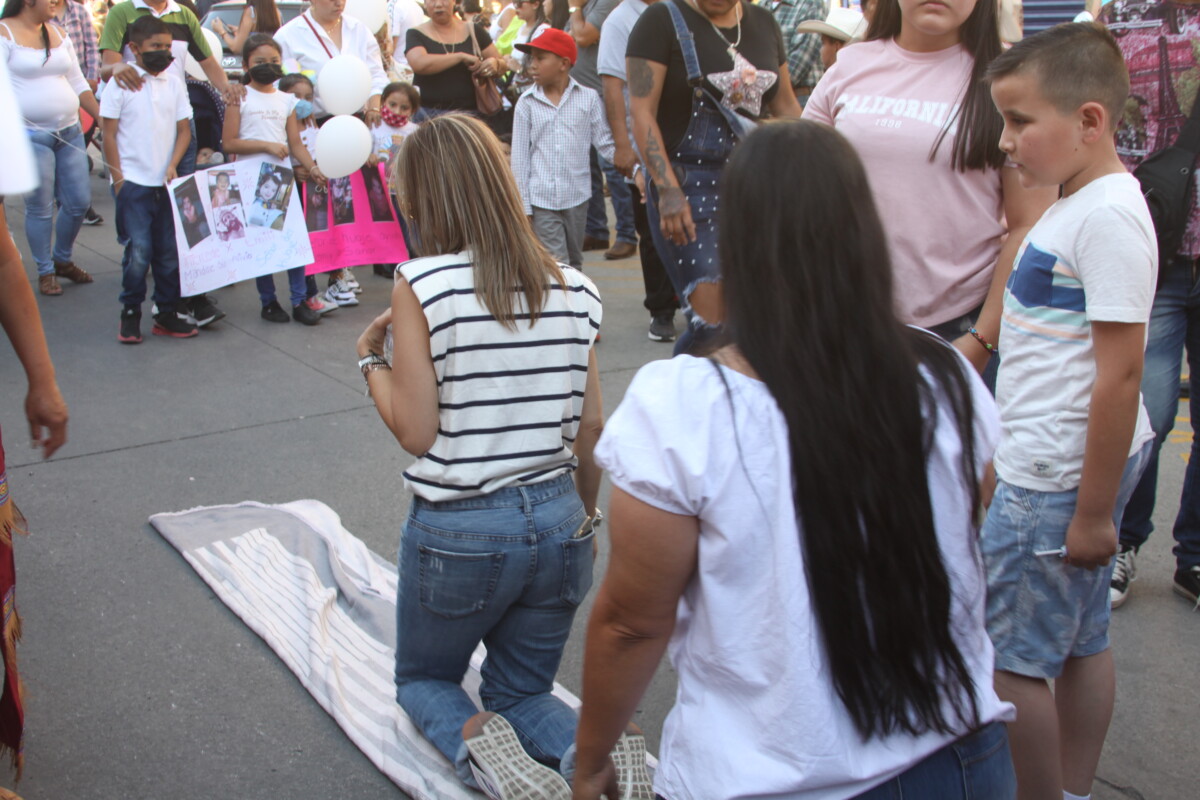
Many parishioners go to meet the icon on their knees.
There are lines of people kneeling to approach the crucified figure to fulfill a request or ask for a favor.
The route of a couple of hours is a mosaic of dancers with multicolored feathers and costumes, musicians with their polished costumes and the honor guard with their bright red shirts.
The sound of the drums announces the approach of the procession. As it passes, the figure of the crucified Christ, almost three meters high, draws sighs and tears.
In a loudspeaker, the voice of a woman prays and sings, “There are eyes that, if they look at me, make my soul tremble with love, they are such beautiful eyes…”
The Lord of the Huaje is carried on a special platform driven by a man. He advances, standing out among the crowd with his gaze towards the sky, towards the mountains, towards the faithful who sometimes look into his eyes. “Because He lives,” says a woman next to me, ecstatic with fervor.
Translated by Sandy Britton
Praying as they walk, pilgrims ascend trail to the cross on the hill in Jocotepec
Pilgrims pray as they walk, a rosary in one hand. Photo: Hector Ruiz.
Héctor Ruiz Mejía (Jocotepec).- About 500 people, fewer than in past years, attended the traditional pilgrimage to the cross on the hill of the municipal seat of Jocotepec, on May 3.
The difficult trail ascends for more than 1.7 kilometers (about a mile) and takes an average time of one hour and 40 minutes.
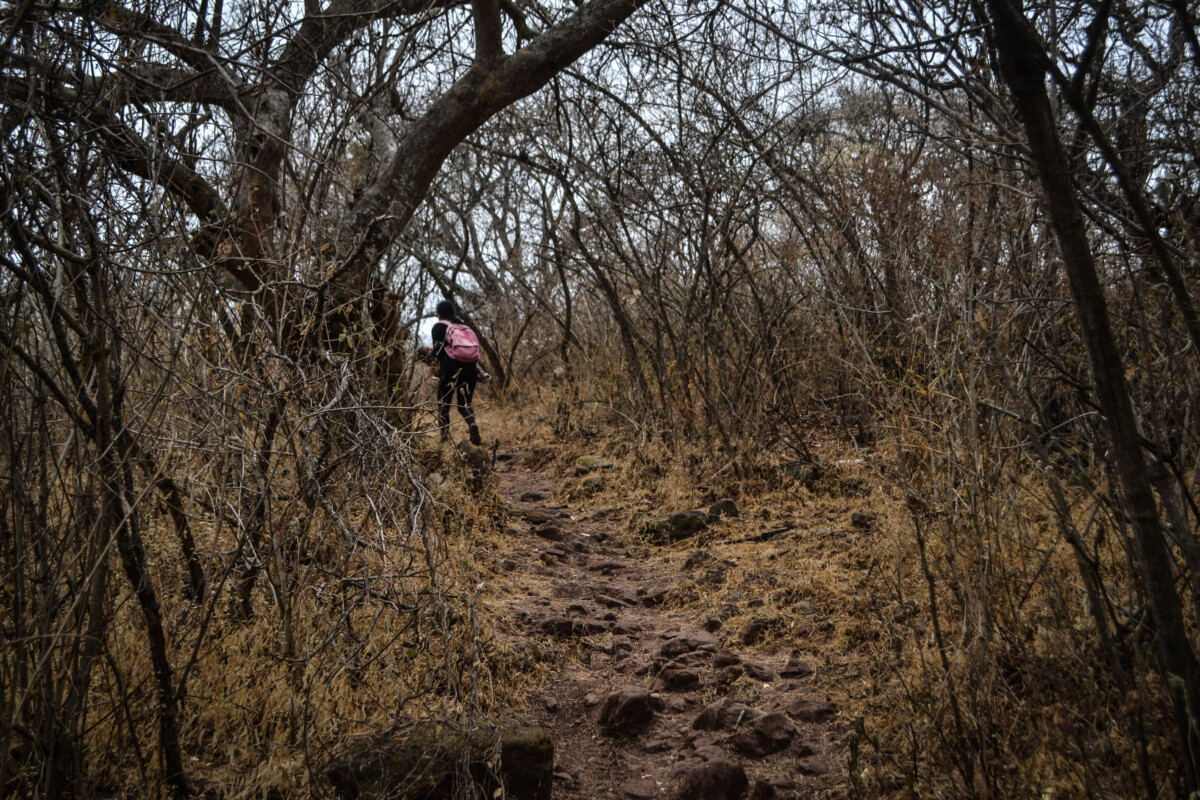
Enjoying the view from the top of the Jocotepec hill. Photo: Hector Ruiz.
Authorities from the Jocotepec Civil Protection and Fire Department, who were providing assistance for the walkers, said they counted approximately 500 people.
“In past years, we had groups of up to 100 people in a row,» one said, suggesting that the traditional event may be in decline.
As a result, the firefighters and paramedics in attendance had little to do.
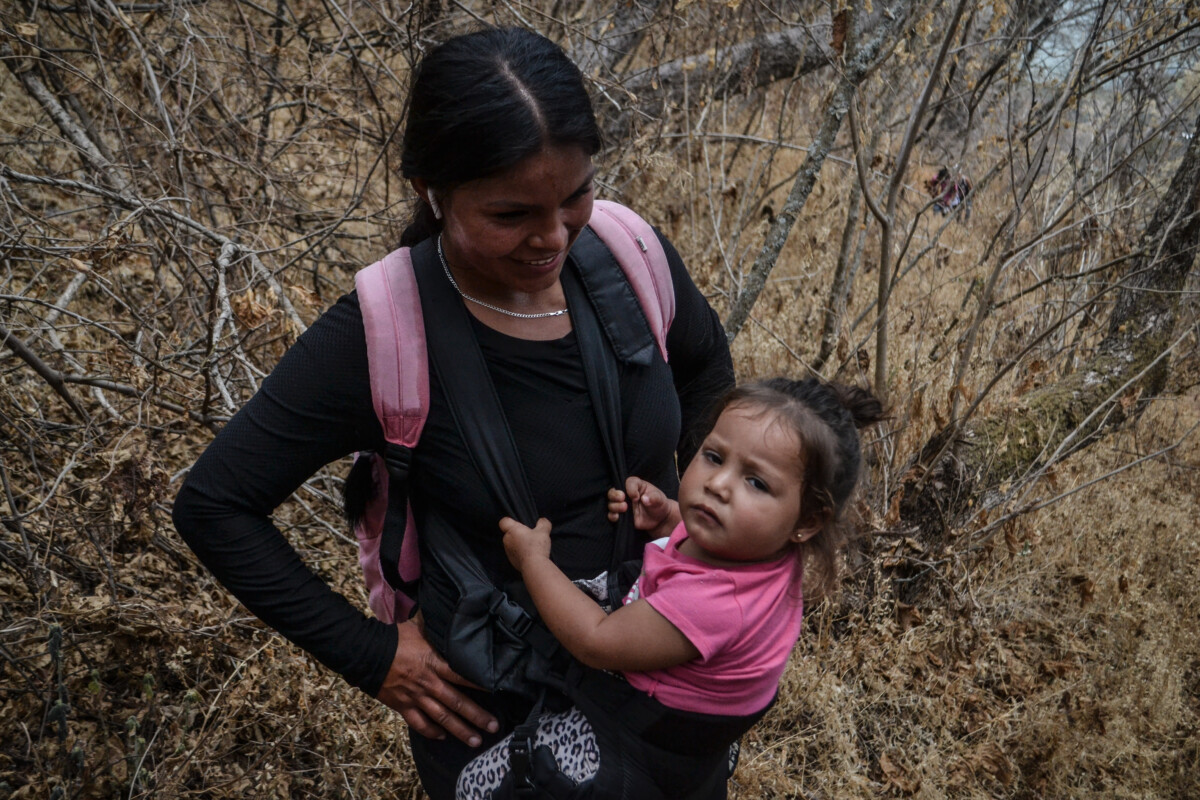
A woman climbs the hill at a rapid pace. Photo: Hector Ruiz.
Among the faithful who did take part was Gustavo, who said he had made the pilgrimage «his whole life” — asking Christ for help and thanking Him for what he has already.
“Every year I come here to pray . . . and to remember the importance of this tradition for our people,” he said.
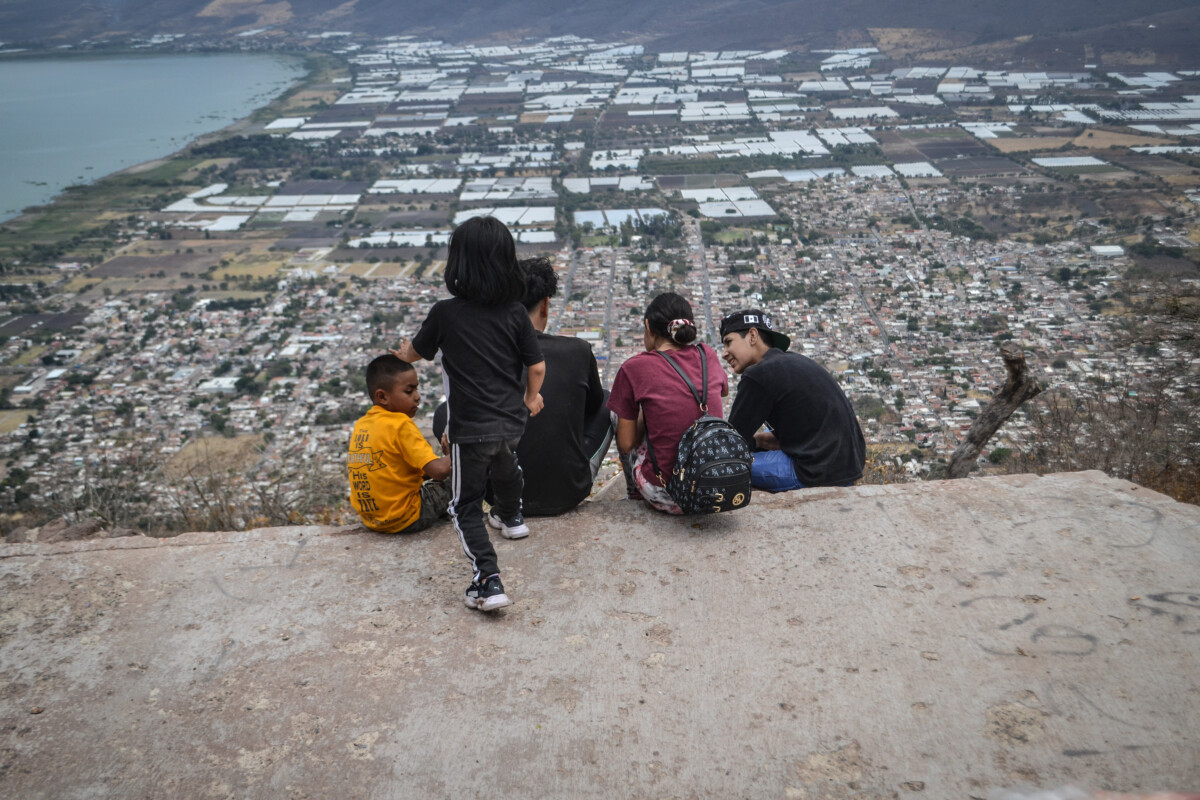
The municipal seat viewed rom the top of Jocotepec hill. Photo: Hector Ruiz.
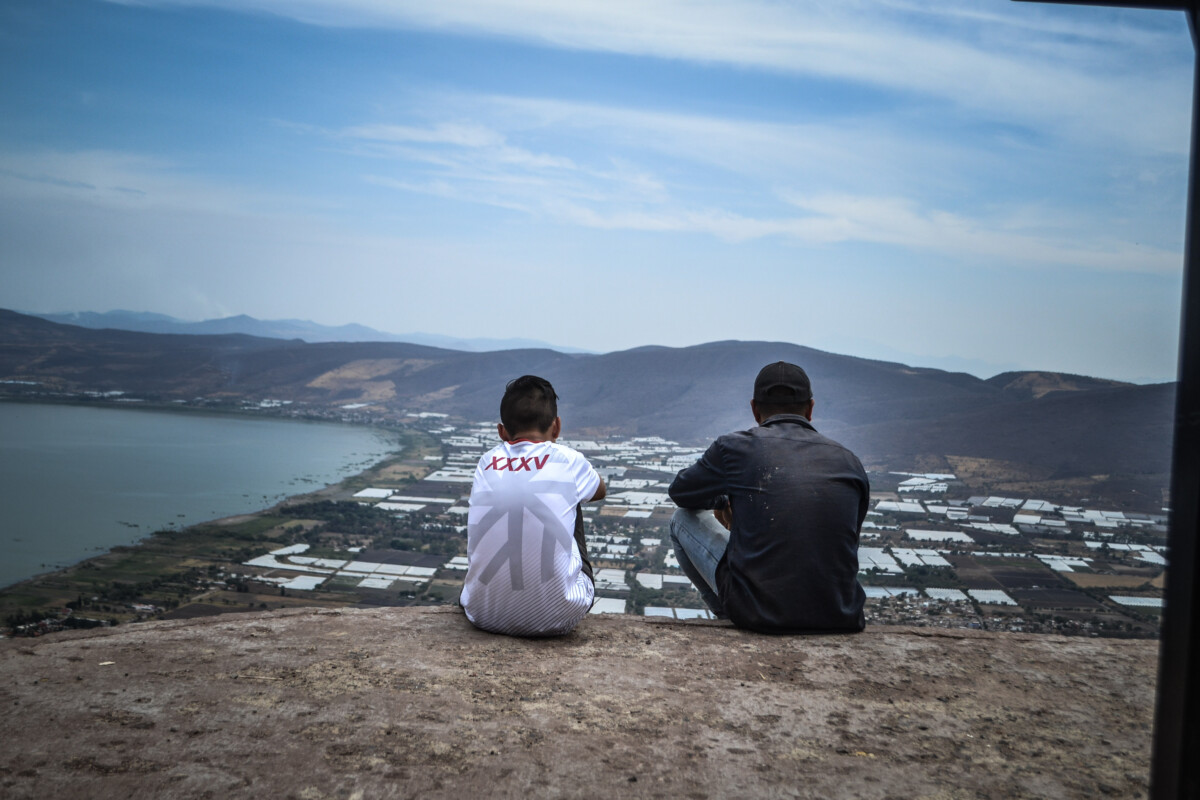
Father and son admire the view of Lake Chapala. Photo: Hector Ruiz.
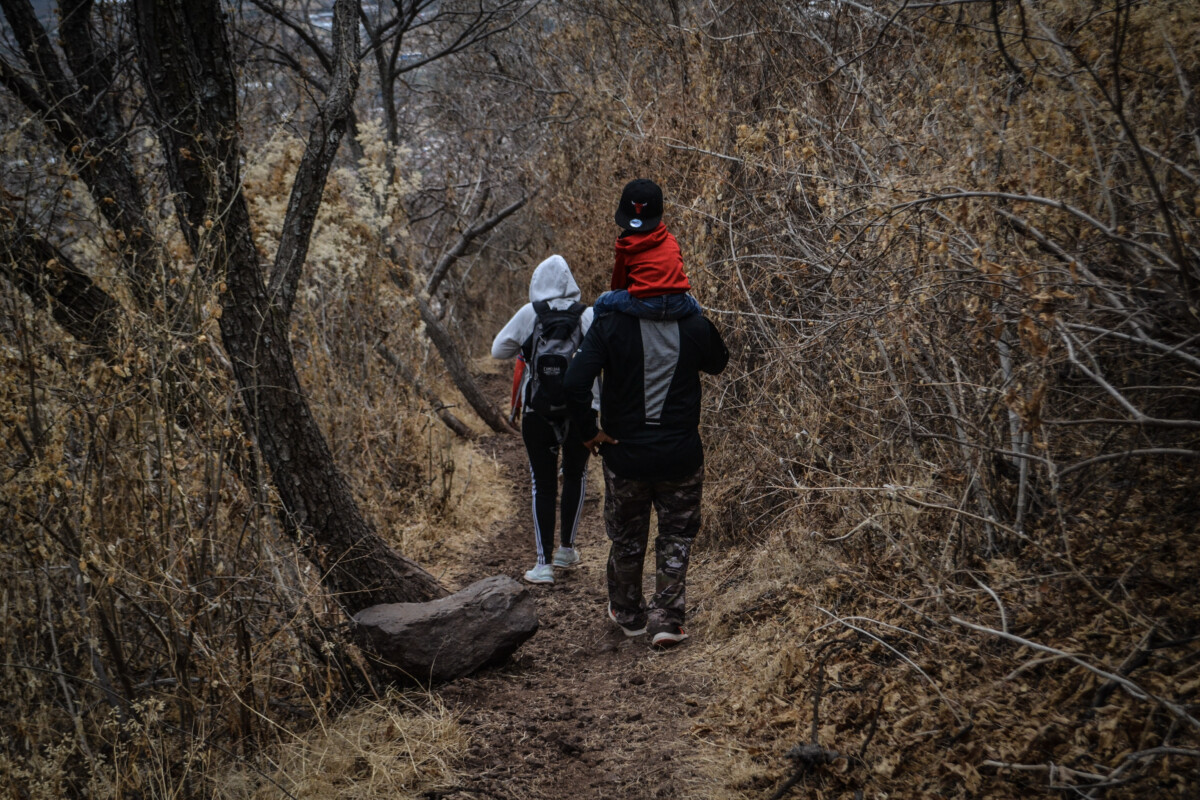
Beginning the difficult journey back, with another 1.7 kilometres to go. Photo: Hector Ruiz.
Translated by Alan Ferguson
Detienen a dos hombres en Chapala por robo a iglesia
El robo se efectuó en la parroquia de San Francisco de Asis. Foto: Archivo.
Redacción.- Dos hombres fueron detenidos por presuntamente robar más de 6 mil pesos en una iglesia de Chapala.
Personal de la Fiscalía Regional puso a disposición de los jueces que los requerían con una orden de aprehensión por el delito de robo calificado.
Se trata de Yahir Alejandro G. y Víctor Alfonso C., quienes fueron detenidos en la calle Isla del Presidio al cruce con De los Maestros, de la colonia Gastronómica, en el municipio de Chapala.
Los hechos por los que fueron capturados ocurrieron la semana pasada y, de acuerdo con las indagatorias estas personas ingresaron a la iglesia de San Francisco de Asís, forzaron un lucernario de monedas que se encontraba a pie de una imagen católica y extrajeron la cantidad de 6 mil pesos, motivo por el cual les resultó la orden de aprehensión.
Ambos fueron puestos a disposición del Juez de Control y Juicio Oral del Quinto Distrito Judicial, quien resolverá su situación jurídica. Las personas detenidas serán tratadas como inocentes en tanto no se emita una sentencia en su contra.
The celebration of the Señor del Huaje returned to Jocotepec
Processions of the Señor del Huaje in previous years.
Héctor Ruiz Mejía (Jocotepec).- After two years of suspension due to the pandemic, the festivities in honor of the Lord of Huaje, in the municipality of Jocotepec, returned.
The activities began April 23, with fireworks shows, regional music in the main square, and daily processions that have traveled to different localities and neighborhoods of the municipality, with participation by all parts of society. During the celebration, a carved wooden Christ, three meters high and weighing approximately half a ton, also known as the Santo Cristo de la Expiración, once again walked the streets of the town after two years of prohibitions and confinement due to the Covid-19 pandemic.
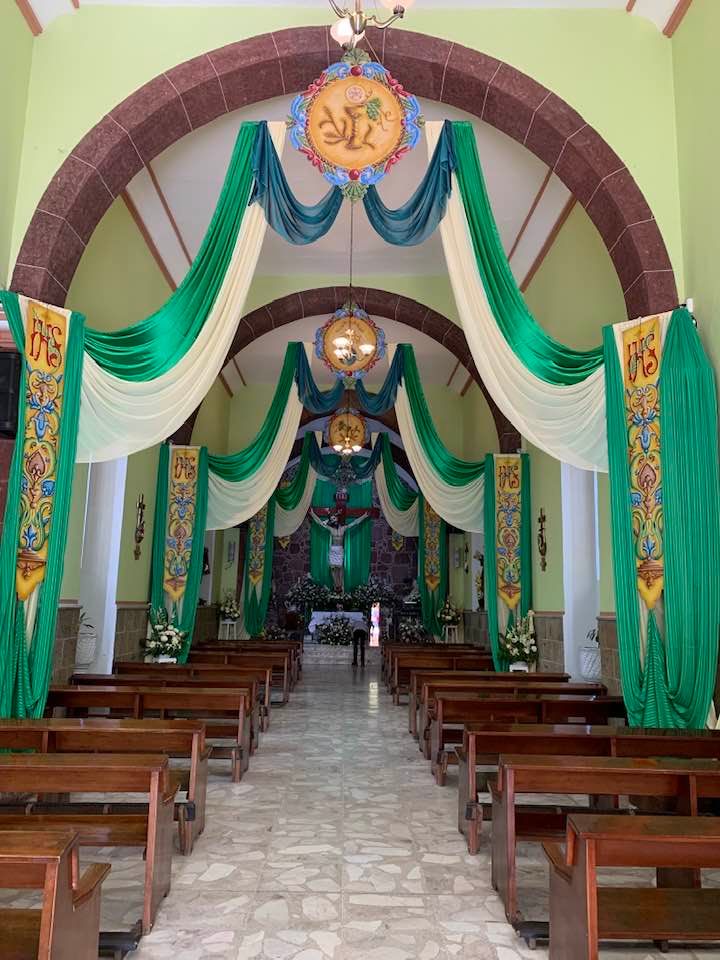
This is how the Señor del Huaje Church looks this year, ready for its festivities.
This year carnival games and rides occupied Miguel Arana Street up to its intersection with Guadalupe Victoria, so that all this week, traffic was affected and those attending had to find alternative places to park.
This Sunday, May 1st, the festivities culminated with the Solemn Procession with the blessed image of the Lord of Huaje, which began at 5 pm traveled through the main streets to return to the mass at 7 pm in the atrium of his chapel.
At the end of the Eucharist, residents enjoyed the music, dances and food stalls, as well as the carnival rides and games and the fireworks display, produced by the masons’ guild this year.
The cult of the Señor del Huaje is one of the oldest in the region, since its appearance dates back to 1715 in a guaje tree in what today comprises a property located in the town of San Pedro Tesistan.
Translated by Patrick O’Heffernan
FOTOGALERÍA:
El Señor del Huaje es el Cristo más importante para el municipio de Jocotepec, pues desde su aparición hace poco más de 306 años, propició el culto de los otros dos Cristos importantes para la comunidad ribereña. Foto: Héctor Ruiz.
Héctor Ruiz Mejía.- Con la participación de más de dos mil fieles, bajo el intenso calor, se reanudó la festividad del Señor del Huaje, luego de dos años de cancelación por la pandemia.
El Cristo, con más de 306 años de historia, dio su tradicional recorrido por las calles de la cabecera de Jocotepec, donde, escoltados por la Guardia de Honor, el Mariachi Nuevo San Juan y los fieles, inundaron las calles tras su salida de la Iglesia.

El Cristo de más de media tonelada de peso, es venerado antes de ser montado y bajado para su procesión. Foto: Héctor Ruiz.

Alrededor de las cinco y media, comenzaron las maniobras para desmontar al Señor del Huaje de su base en la Iglesia y dar la tradicional procesión. Foto: Héctor Ruiz.

La Iglesia del Señor del Huaje, hasta el tope de gente, esperando a que salga el Cristo por las calles del municipio. Foto: Héctor Ruiz.

Bajo el intenso calor y la resolana, comenzó la procesión por las calles. Foto: Héctor Ruiz.

El Señor del Huaje, siendo transportado desde la parroquia hasta el carro alegórico donde se instaló para ser transportado por las calles de Jocotepec. Foto: Héctor Ruiz.

Las calles del municipio, inundadas de fieles, que seguían al Cristo. Foto: Héctor Ruiz.
Chronicles of La Ribera
The character of Pontius Pilate, accompanied by his wife and the women of his palace.
There are a little over 50 actors on stage, including girls, boys and adult men and women. Since last February they began to prepare the representation of the Passion of Christ in the municipal capital of Jocotepec.
A few minutes before the beginning of the Stations of the Cross, the participants take care of the last details gathered in the pastoral house of the parish of Señor del Monte. They arrange their hairstyles and tunics and the leaders give instructions.

The actors leave the parsonage to begin the presentation.
Pedro Gómez Monreal is one of the organizers; also Benjamín Ramos Bautista. The last three weeks have been arduous rehearsals.
Lucia Mendoza is an elementary school teacher, she represents Pontius Pilate’s wife; she is dressed in a pearl-colored dress with satin sleeves and a golden diadem. For the teacher Luci it is extraordinary to be able to transmit a living God through the characters that she and her classmates represent.

The smallest of the actors is carried in his arms.
There is also her father, Don Pedro Mendoza, the wool serapes maker, who yesterday represented the apostle Peter. Today he appears along with men and women of the town.
-Yesterday I cried,» he says, saddened.
«It doesn’t feel good to deny my God, let alone three times».
Angel Gael Ramos also represents a boy from the agitated town that demands the Crucifixion of Jesus. From a very young age he has accompanied his parents and now he does so from the character assigned to him.
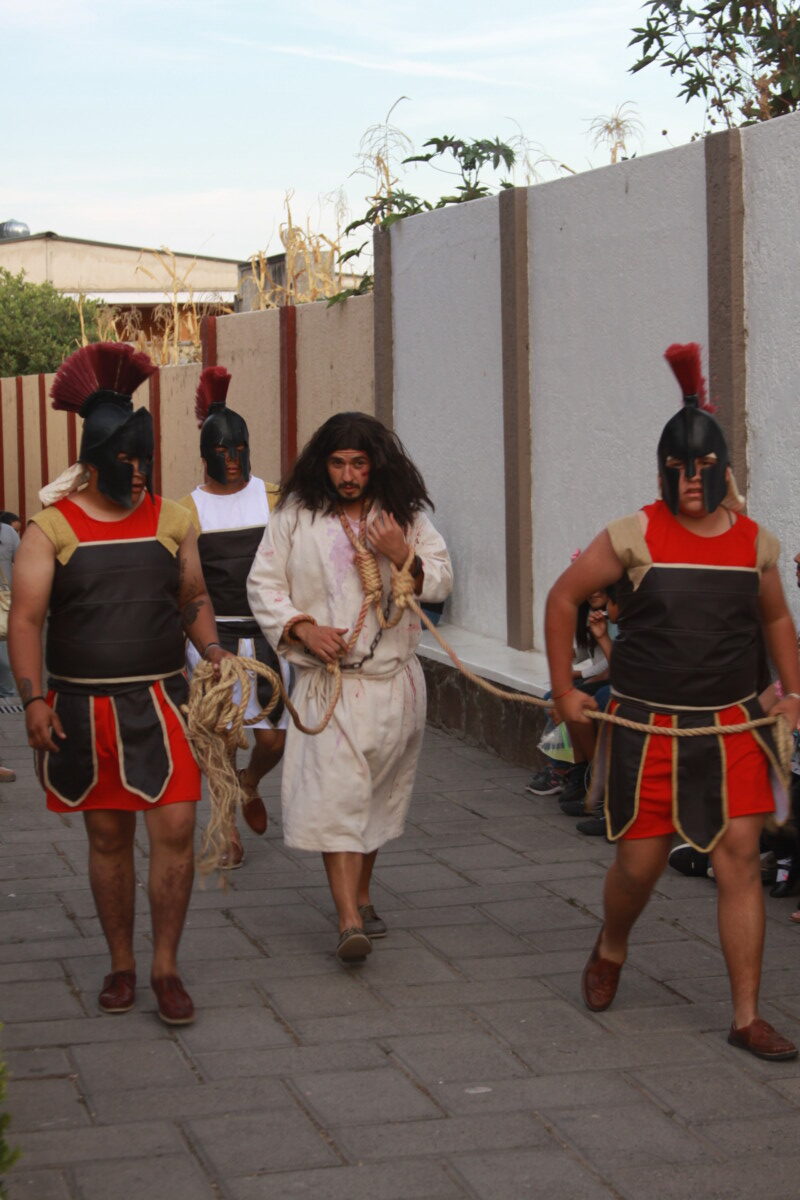
Jesus is escorted by the soldiers in his first appearance.
The Jesus Christ of this 2022 edition is represented by Cristian José López López.
The parishioners are already in the atrium waiting. The three stages of the first Stations of the Cross are ready. In the first one, Pontius Pilate appears, played by Pedro Gómez and his wife amidst purple curtains. On another stage is Herod surrounded by his servants. Jesus goes from one stage to another amidst pushing and whipping by the soldiers amidst the shouts of the people.

Herod from his court judges Jesus.
In another painting, there is a huge trunk to which the Nazarene is tied. There he is scourged before the eyes of the actors who represent the enraged mob and the parishioners who live the Stations of the Cross.
A girl of about ten years old, dressed in a brown tunic, watches with anguished eyes; she anxiously pinches a wooden cane that she carries in her hands.

Jesus about to be scourged.
Amidst mocking laughter and pushing and shoving, the enormous wooden cross is placed on the shoulders of the personage of Jesus Christ. The faithful continue to pray the Stations of the Cross through the main streets of Jocotepec.
The night has fallen, from the celestial vault a round and brilliant moon observes us. Next to the solemnity of the prayers, a woman appears with a tricycle selling corn, chickpeas, peanuts and snacks. Accompanied by a girl, she observes the passing of the Viacrucis and continues on her way. The diner is open, «Today tamales and atole », says a small sign. A woman who dines pauses as the procession passes by. The flower shop is also open and a few people watch the Stations of the Cross from inside.

The characters observe the scourging of Jesus.
On arrival at the church, the crosses of the thieves Dimas and Gestas are raised and the cross of Jesus Christ is being prepared. The people swirl around the final scene, the atrium remains in darkness; the disturbing faces of some of the assistants are illuminated by the lamps outside.
Soldiers place Jesus on the cross without his clothes, holding him by his hands and feet and then lifting him up, supported by thick ropes.
In the midst of the funeral atmosphere, the thunderous reggaeton coming from a Razer type vehicle that passes outside the temple interrupts the ceremony while the attendees ignore it.

A little girl, anguished, looks at the scourging and mockery directed to Jesus.
The scene is complete, the silhouettes of the three crosses can be seen amidst the foliage of the trees illuminated by a white light that focuses on the faces of the characters.
With a bloodied body, the crucified man pronounces his last words before the anguished gaze of the audience.
-Judas hanged himself,» shouts a male voice.
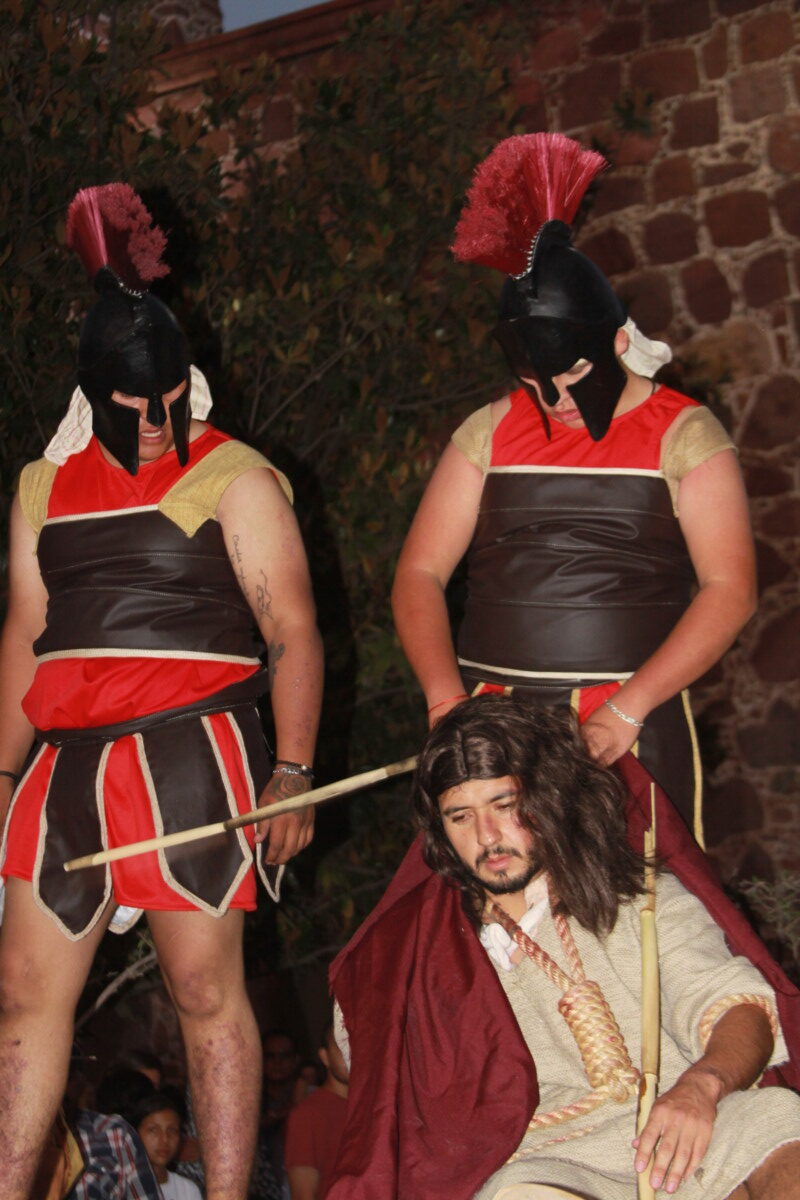
The soldiers are about to scourge the Nazarene.
And the people turn their gazes to the back stage where the silhouette of a man hangs from a rope.
The agony of Jesus is again interrupted by the Razer with the song that passes by for the second time sporting a bar of colorful light.
The faithful concentrate on the naked and battered figure of the crucified man who, on the verge of expiring, exclaims:
-In your hands I commend my spirit-.
-Into your hands I commend my spirit.
Immediately, a voice floods the scene.
-He is trembling!
And everyone kneels down.
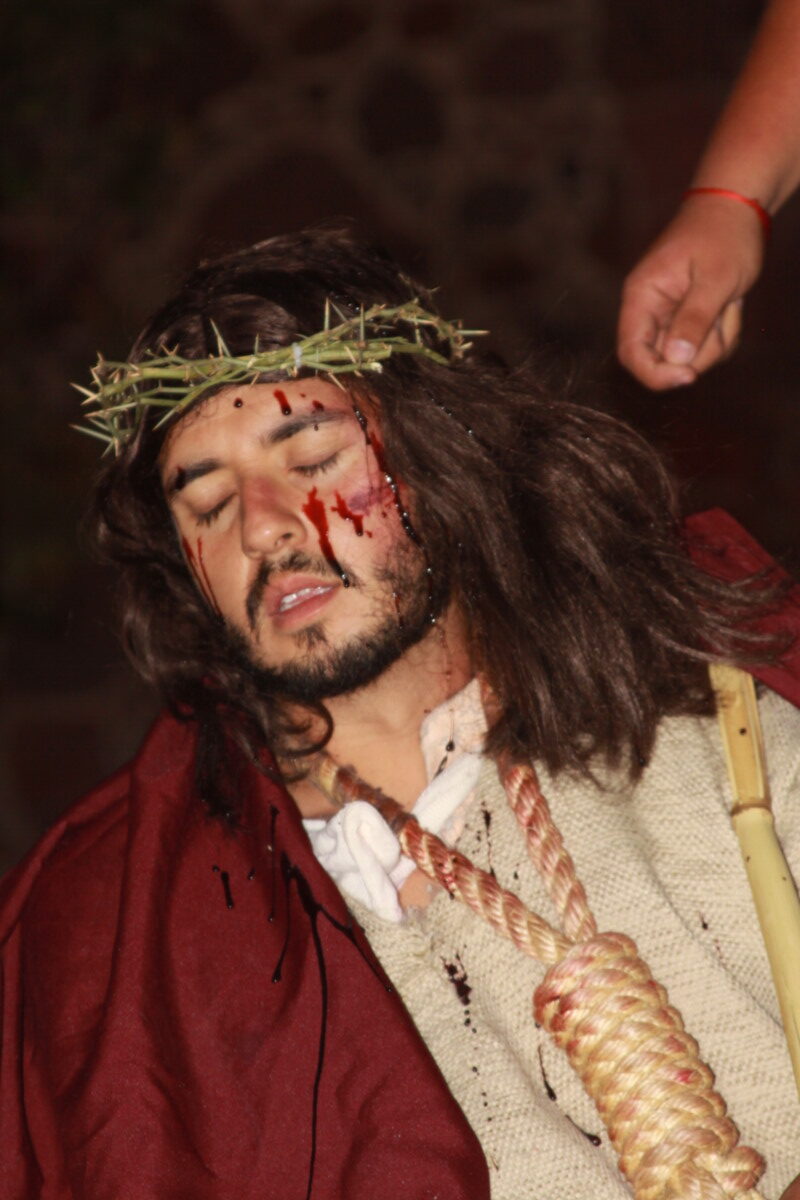
Jesus crowned with thorns.
At the foot of the cross is the character of Mary accompanied by John and another woman.
The young man playing John is indeed weeping bitterly. He takes Mary by the arm with a face bathed in tears, a face that is really living the Calvary and death of the true Son of God and wipes her tears again and again, because for him his companions are at that moment the characters of the sacred scriptures and the atrium of the parish, it is not the atrium, but Golgotha itself.
Translated by Patrick O’Heffernan
Little Chapel of the Rosary needs more repair than estimated
Volunteers working on the repairs. Credit: Sofía Medeles.
Sofía Medeles.– Since the maintenance and repair work began on the Chapel of the Rosary, the group working on the project realized that the damage was greater than what was estimated before they began the restoration. Additional damage was found after work began; the workers found more cracks than they had initially noticed.
In an interview with Semanario Laguna, Josué Ramos, the current president of the volunteer group Sumando Voluntades, shared that the original project budget was $850,000 pesos (about US$42,000). After the National Institute of Anthropology and History (INAH) evaluated the building they said it could probably be repaired for less. Ramos asserted that a budget of $1,000,000 (US$50,000) is more feasible as they may uncover additional work that needs to be done. The group has only raised about $500,000 pesos (US$25,000).
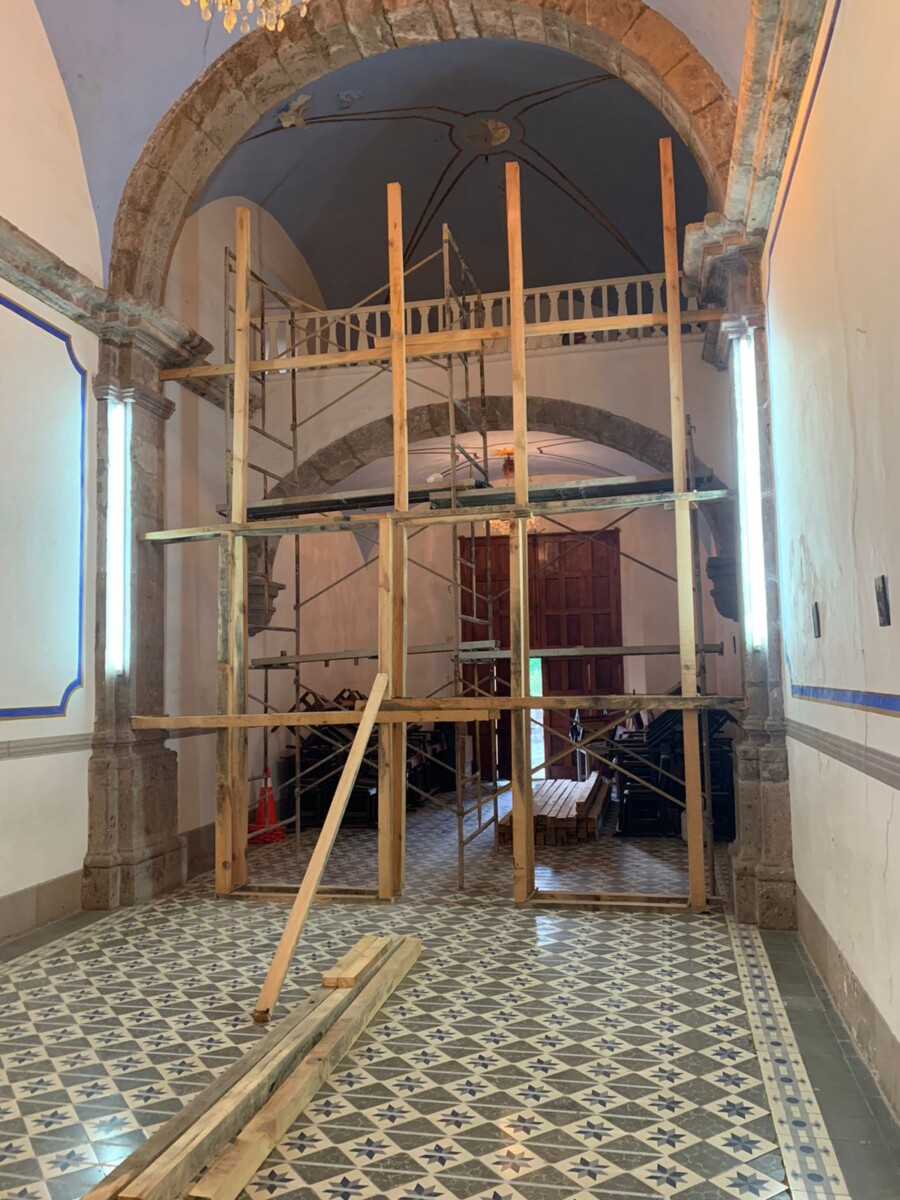
Work is in progress inside the chapel. Credit: Josué Ramos.
«INAH suggested only filling cracks and repairing the water damage in the roof, but we also want to fix the structural problems including reinforcing the structure, and the foundation. This will be evaluated after INAH’s visit, which will ensure that the structure remains as faithful as possible to its original design,» added Ramos. Another member of the group, treasurer Mónica Gutiérrez, assured that despite being more damage than they expected, they are already seeking bids to buy the necessary material to fill the cracks, and continue with the work on the roof.
The committee of Sumando Voluntades recently restructured after the death of their former president, Armando. The new officers are: president and architect Josué Ramos, secretary Juan Antonio Miramontes, and treasurers Monica Gutierrez and Honorata Gómez. To make donations, you can go to «Pollería Gutiérrez” in Ajijic, where one of the treasurers is located. You can also donate by going to any BBVA bank; use bank account number 4152 3137 0415 7622 in the name of Honorata Gómez to donate.
Translated by Amy Esperanto
Chronicles from La Ribera:
Curate Carlos Enrique Medina Garibaldo presides over the Palm Sunday procession in San Cristóbal Zapotitlán. Photo: María Reynozo.
By: María del Refugio Reynozo Medina
The women sweeping the square and the atrium of the temple of San Cristobal Zapotitlán announce the proximity of a celebration: the solemn mass of Palm Sunday.
A row of palm trunks are placed at the entrance of the temple, forming a path to reach the church. At the end, they carry a palm embedded in the center that rises towards the sky.
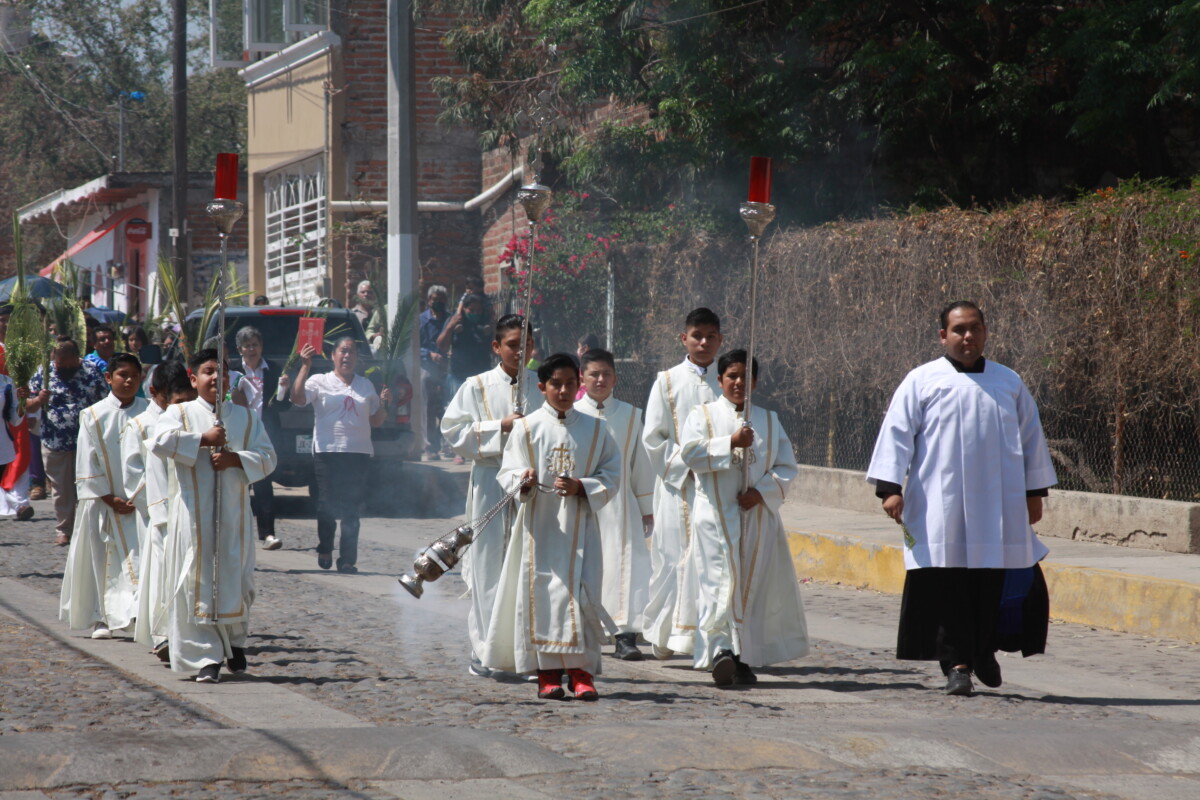
About a hundred parishioners participate walking led by the acolyte children. Photo: María Reynozo.
Two women sweep the scene, while in the square others pick up the garbage with the first rays of the sun shortly after eight in the morning.
Today, in addition to the Palm Sunday celebration, the 2022 recall election is taking place.

Chamomile and rosemary perfume the streets as the procession passes by. Photo: María Reynozo.
Around 11:30 a.m., parishioners congregate on Zaragoza Street in San Cristobal, near the crossroads. They carry bouquets of rosemary and chamomile. Some women carry babies in their arms; others in strollers.
A group of six people, four women and two men, carry light green braided palms, and two of them hold a bible in their hands as they advance in the procession.
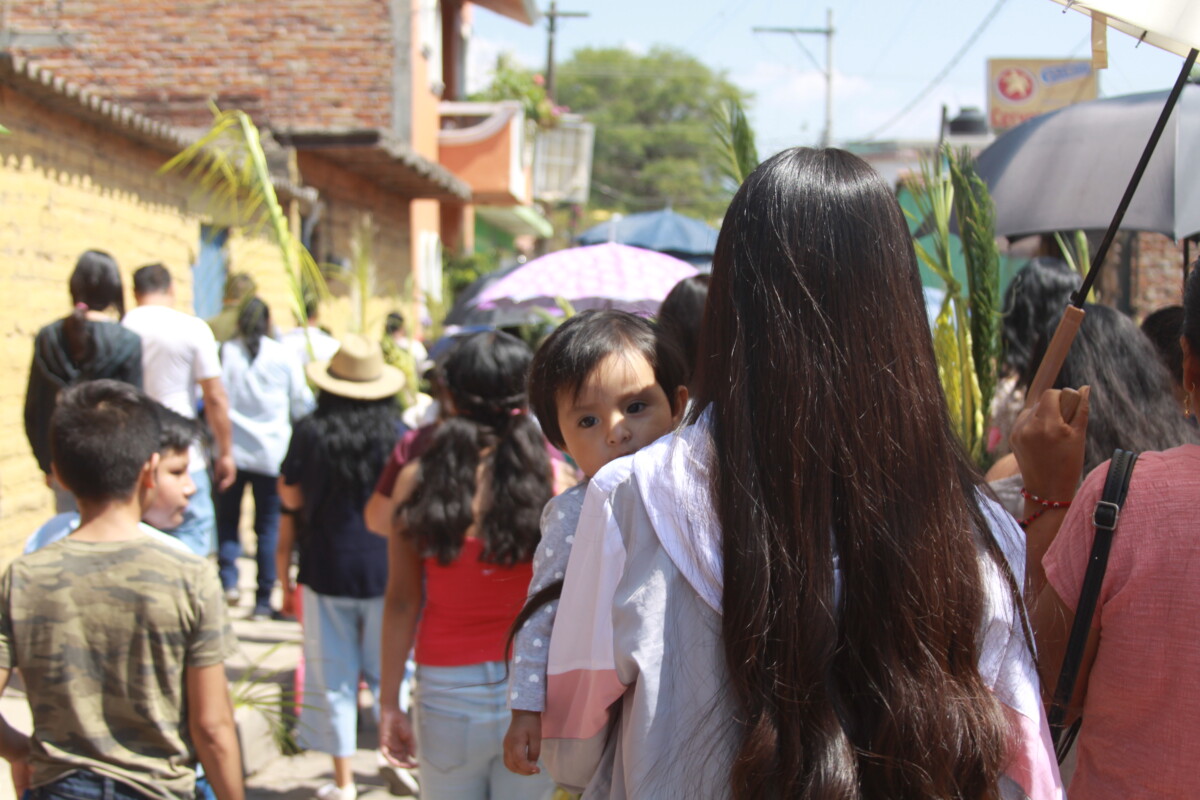
Children accompanying their parents participate in the procession. Photo: María Reynozo.
A group of men in bright robes characterize the apostles, while a young man in the role of Jesus Christ walks dressed in a white tunic and a red cloak. Cura Carlos Enrique Medina Garibaldo leads the procession that advances amidst chants and the aroma of copal.
The atmosphere smells of rosemary, basil and chamomile.
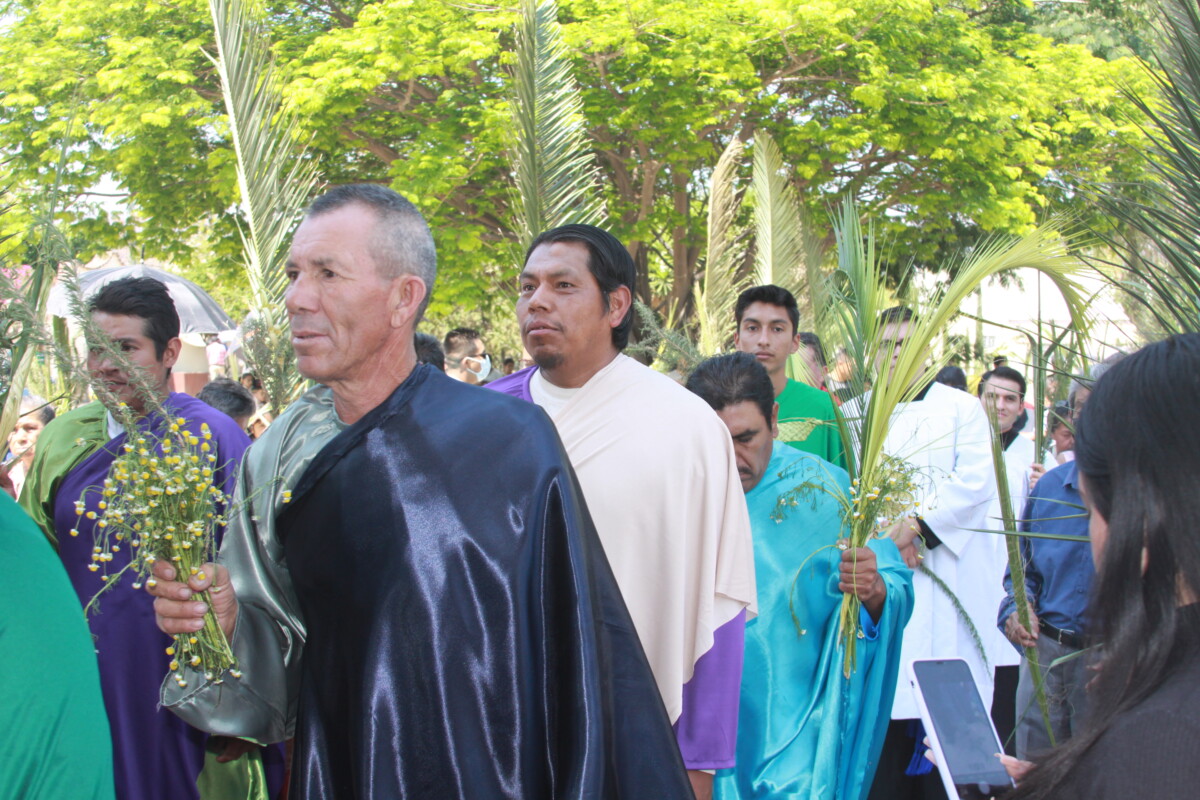
A group of men represent the apostles with their bright tunics. Photo: María Reynozo.
At the end of the celebration, people congregate in the plaza and many treat themselves to carnitas tacos, steak tacos or a slice of flan.
Meanwhile, in the premises a few meters from the elementary school, the ballot boxes are set up to carry out the recall referendum promoted by the President of Mexico, Andrés Manuel López Obrador (AMLO).
The polls opened at 8:00 a.m. and a few minutes later; however, at 8:30 a couple of the first voters appeared alone.
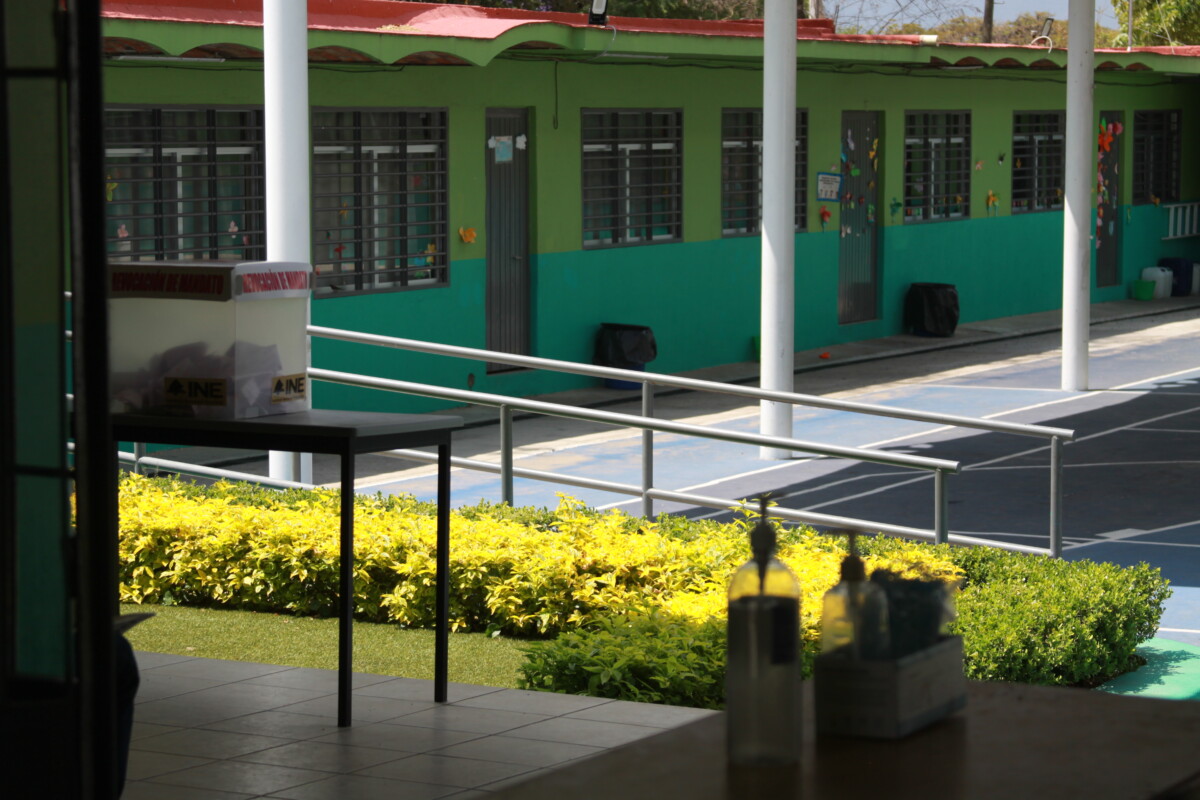
In the elementary school, the urns look lonely. Photo: María Reynozo.
Two polling places are installed; from section 1668 and 1687. Each polling place has a president, a secretary and a teller.
The arrival of voters is slow; and out of a voter roll of about three thousand, only 275 voters are present and the majority decision is for the incumbent president to remain.
This is how the announced recall process goes; between the bells that call to mass and the ballot boxes that call to vote where the fragrant rosemary bouquets exceeded by dozens the participation of the citizens.
Joel Salvador Torres Arrayga is the Jesus of the Passion of Christ Chapala 2022
Joel Salvador – Chapala. Torres Arrayga , who will portray Jesus in the Stations of the Cross and Passion of Christ Chapala 2022, next to Father Juan Manuel. Photo: Jazmín Stengel.
Jazmín Stengel.- Joel Salvador Torres Arrayga, originally from Chapala, was always devout and, although his work took him away from the ecclesiastical groups for a few years, he returned this year, to represent Christ during the Stations of the Cross and Passion of Christ Chapala 2022.
The 25-year-old was familiar with the Church throughout his life. Coming from a Catholic family, as a child he was an acolyte or altar boy in the parish of San Francisco de Asis. Years later, in his adolescence he was part of the Seminarians in Family (SemFam) group coordinated from the same parish, and during his high school years he was a member of the Salesian Missionary Group of Chapala.
This year, due to his long and curly hair, he was invited by the ‘Bola’ and Jesús Chávez to be part of the new group that re-enacts the Stations of the Cross and Passion of Christ in the municipal capital.
Translated by Patrick O’Heffernan
Holy Week begins with attendance of the faithful in San Juan Cosalá
The commemoration of Palm Sunday began with the traditional route from the Malecon (boardwalk) to the church of San Juan Cosalá. Photo: Alma Serrano.
Alma Serrano(San Juan Cosalá).- Catholics packed the atrium of the San Juan Bautista church in San Juan Cosalá to commemorate Palm Sunday at the beginning of Holy Week. The celebration began shortly before 8:00 a.m., when the faithful gathered on Del Cardenal Sur Street, next to where the Malecon (boardwalk) begins, to bless the palms.
Afterward, the procession began the journey to the church, emulating the triumphal entry of Jesus Christ into the city of Jerusalem and his confirmation as the son of God. Palm branches, prayers, faith, and emotion were the essence of the celebration in the community.
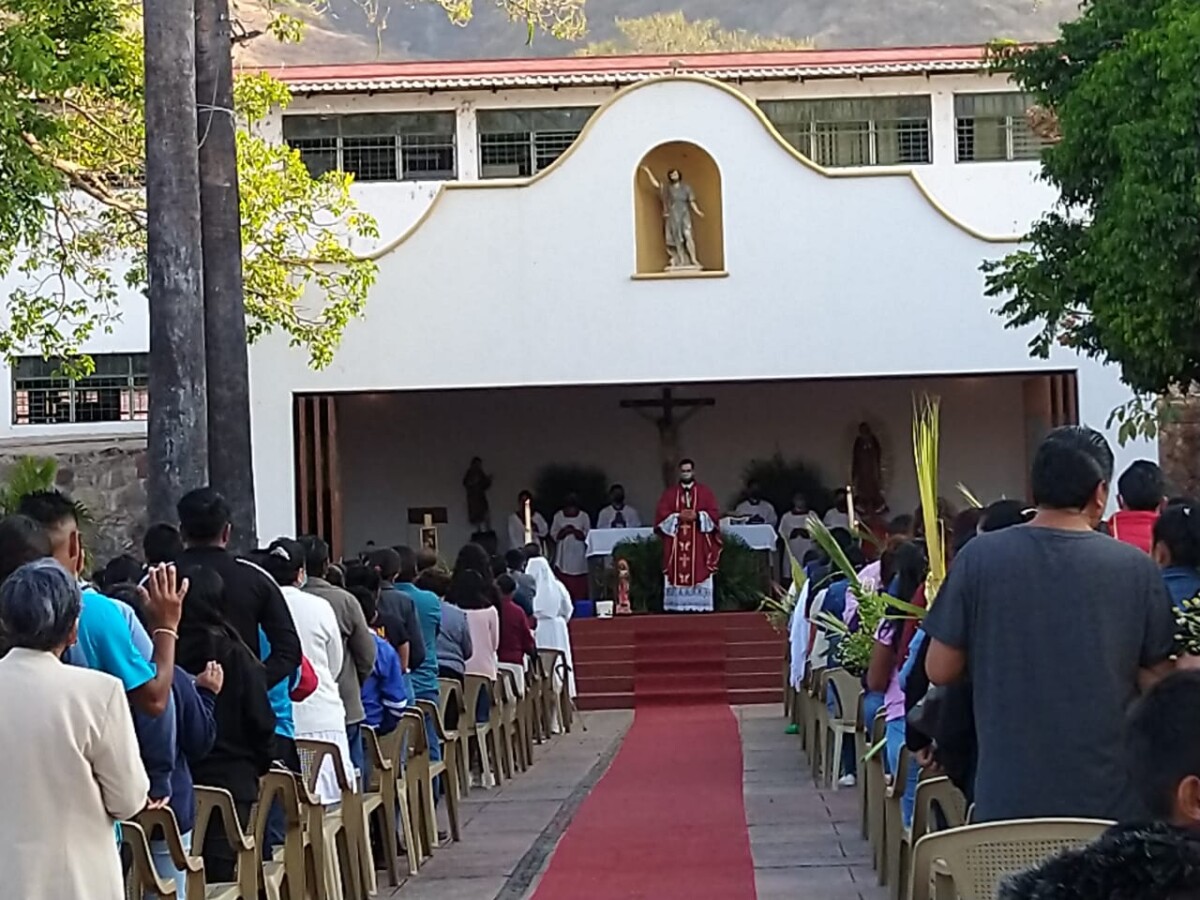
Approximately 400 people crowded the atrium of the Parish of San Juan Bautista. Photo: Alma Serrano.
This sacred act brought together around 400 people, who joined together to bid farewell to Lent and begin Holy Week, which lasts until Sunday, April 17, a time dedicated to remembering the passion, death, and resurrection of Jesus.
«These are not holidays, they are holy days, we need to meet again with the one who lost his dignity and take up our lives in the best way, let’s do the best with our lives because we only have one here on earth», said during the sermon the priest Ramón Ramírez López.
Also present at the ceremony, on both sides of the altar, were representatives of the 12 apostles. During the Eucharist, more than 70 people received communion, including children, young people, adults, and senior citizens, most of whom took appropriate sanitation measures.
Translated by Nita Rudy
© 2016. Todos los derechos reservados. Semanario de la Ribera de Chapala


